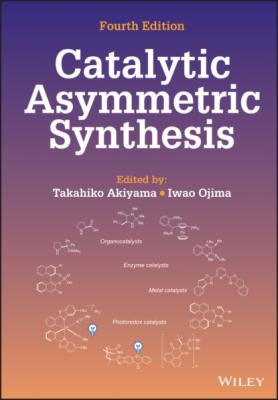Catalytic Asymmetric Synthesis. Группа авторов
Чтение книги онлайн.
Читать онлайн книгу Catalytic Asymmetric Synthesis - Группа авторов страница 64
 but also in carbon‐heteroatom bond formations [69], such as α‐hydroxylation of tetralone‐derived β‐ketoesters [70].
but also in carbon‐heteroatom bond formations [69], such as α‐hydroxylation of tetralone‐derived β‐ketoesters [70].
Scheme 3.38. Solvent‐dependent enantiodivergent Mannich‐type reaction catalyzed by 25b.
Source: Based on [68].
Feng and co‐workers designed bifunctional guanidine catalyst 26a featuring a chiral amino amide backbone, in which an amide moiety functions as a hydrogen bond donor unit [71]. The catalytic activity was demonstrated in the enantioselective addition of β‐ketoesters to nitroalkenes (Scheme 3.39).
Scheme 3.39. Enantioselective addition of β‐ketoesters to nitroalkenes catalyzed by 26a. Source: Based on [71].
Liu, Feng, and co‐workers later developed related guanidine‐amide bifunctional catalysts, such as 26b, 26c, and 26d, and successfully utilized them in several enantioselective reactions (Scheme 3.40) [72].
Scheme 3.40. Enantioselective reactions catalyzed by 26.
Source: [72].
Wang, Qu, and co‐workers developed tartaric acid‐derived seven‐membered cyclic chiral guanidine 27, and utilized the catalyst in the enantioselective α‐hydroxylation of β‐ketoesters and β‐diketones with oxaziridine (Scheme 3.41) [73]. This type of chiral guanidine catalyst was also used in the Michael addition of 3‐substituted oxindoles to nitroalkenes [74].
Scheme 3.41. Enantioselective α‐hydroxylation of β‐ketoesters catalyzed by 27.
Source: Based on [73].
Tan and co‐workers developed an aminoindanol‐derived chiral guanidine 28. The catalyst was utilized in the desymmetrization of meso‐aziridines with thiols and carbamodithioic acids as a pronucleophile, providing the ring‐opening products in high yields with high enantioselectivities (Scheme 3.42) [75].
Scheme 3.42. Desymmetrization of meso‐aziridines with thiols catalyzed by 28.
Source: Based on [75].
Aforementioned all chiral guanidine catalysts control the stereoselectivity of the bond‐forming process based on the central chirality of the catalyst molecule. In contrast, Terada and co‐workers introduced, for the first time, the methodology based on axial chirality of the catalyst molecule into the field of chiral guanidine catalysis [76]. Specifically, the group designed two types of axially chiral guanidines having an axially chiral binaphthyl backbone (Figure 3.9). One is the nine‐membered cyclic guanidines 29, in which an N‐C‐N guanidine subunit is involved in the ring structure. The other is the seven‐membered cyclic guanidines 30, in which one nitrogen atom of guanidine is involved in the ring structure.
Figure 3.9. Axially chiral guanidine catalysts.
The high catalytic activity of nine‐membered 29 was demonstrated in the enantioselective Michael addition of β‐dicarbonyl compounds and diphenyl phosphite to nitroalkenes [77]. Both substituents at the 3,3′‐positions of binaphthyl backbone (Ar) and that attached on the guanidine nitrogen (G) had a strong impact on the stereoselectivity of the reactions. Chiral guanidine 29a was also utilized in the enantioselective direct vinylogous aldol reaction of furanones, as well as vinylogous Michael addition of furanones to nitroalkenes, to provide the corresponding adducts in high yields with high enantioselectivities (Scheme 3.43) [78].
Scheme 3.43. Enantioselective reactions of furanones as a pronucleophile catalyzed by 29a.
Source: [78].
On the other hand, the catalytic activity of seven‐membered 30 was confirmed by the highly enantioselective amination of β‐dicarbonyl compounds with azodicarboxylate (Scheme 3.44) [79]. In this catalyst design, the reach of the steric demand exerted by the aromatic substituents (Ar) is important to provide an efficient chiral environment around the substrate recognition site at the guanidine moiety. Therefore, the employment of chiral guanidine 30a with para‐biphenyl substituents having a bulky tert‐butyl groups at the 3,5‐positions of the terminal phenyl ring was essential to achieve the high level of stereocontrol. This type of chiral guanidine catalyst was also utilized in the enantioselective [3+2] cycloaddition of glycine imines with maleate [80].
Scheme 3.44. Enantioselective amination of β‐dicarbonyl compounds with azodicarboxylate catalyzed by 30a.
Source: Based on [79].
3.4. OTHER CHIRAL UNCHARGED ORGANOBASE CATALYSTS: CHIRAL ORGANOSUPERBASES
As described in the previous section, chiral bifunctional tertiary amine catalysts have been recognized as a particular class of chiral Brønsted base catalysts